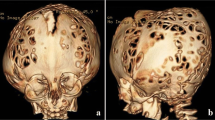Abstract
Osteopathia striata (OS) is a rare bone dysplasia characterized by longitudinal sclerotic striations of the long bones. It is of no clinical importance, but OS associated with cranial sclerosis represents a separate entity with a high incidence of palatine malformations and deafness. Only 19 cases of this entity have been reported in the literature. One patient of this series also had facial nerve paralysis. This paper presents a second case of OS, cranial sclerosis, palatine pathology and recurrent facial nerve paralysis. This incidence of 2/20 (10%) does not seem to be coincidental but raises the possibility that facial nerve palsy is one of the clinical manifestations of this specific bone abnormality.
Similar content being viewed by others
Abbreviations
- OS:
-
osteopathia striata
References
Bloor DU (1954) A case of osteopathia striata. J Bone Joint Surg [Br] 36:261–265
Cortina H, Vallcanera A, Vidal J (1981) Familial osteopathia striata with cranial condensation. Pediatr Radiol 11:87–90
Culver GJ, Thumasathit C (1972) Osseous changes of osteopathia striata and Pyle's disease occurring in a patient with an 11 year follow-up. AJR 116:640–643
Currarino G, Friedman JM (1986) Severe craniofacial sclerosis with multiple anomalies in a boy and his mother. Pediatr Radiol 16:441–447
Franklyn PP, Wilkinson D (1978) Two cases of osteopathia striata, deafness and cranial osteopetrosis. Ann Radiol (paris) 21:91–93
Horan FT, Beighton PH (1978) Osteopathia striata with cranial sclerosis. An autosomal dominant entity. Clin Genet 13:201–205
Hurt RL (1953) Osteopathia striata-Voorhoeve's disease: report of a case presenting features of osteopathia striata and osteopetrosis. J Bone Joint Surg [Br] 35:89–96
Jones MD, Mulcahy ND (1968) Osteopathia striata, osteopetrosis and impaired hearing. Arch Otolaryngol 87:116–119
Larregue M, Maroteaux P, Michel Y, Faure C (1972) Osteopathia striata: radiological manifestations of focal dermal hypoplasia. Ann Radiol (Paris) 15:287–295
Nakamura T, Yokomizo Y, Kanda S, Harada T, Naruse T (1985) Osteopathia striata with cranial sclerosis affecting three family members. Skeletal Radiol 14:267–269
Paling MR, Hyde I, Dennis NR (1980) Osteopathia striata with sclerosis and thickening of the skull. Br J Radiol 54:344–348
Schnyder PA (1980) Osseous changes of osteopathia striata associated with cranial sclerosis. Skeletal Radiol 5:19–22
Taybi H, Murock AB (1969) Discussion of osteopathia striata. Birth Defects 5:105–108
Walker BA (1969) Ostopathia striata with cataracts and deafness. Birth Defects 5:295–297
Whyte MP, Murphy WA, Fallon MD, Hahn TJ (1981) Mixed sclerosing bone dystrophy: report of case and review of the literature. Skeletal Radiol 6:95–102
Winter RM, d'A Crawfurd, Meire HB Mitchell N (1980) Osteopathia striata with cranial sclerosis: highly variable expression within a family including cleft palate in two neonatal cases. Clin Genet 18:462–474
Author information
Authors and Affiliations
Rights and permissions
About this article
Cite this article
Kornreich, L., Grunebaum, M., Ziv, N. et al. Osteopathia striata, cranial sclerosis with cleft palate and facial nerve palsy. Eur J Pediatr 147, 101–103 (1988). https://doi.org/10.1007/BF00442625
Received:
Accepted:
Issue Date:
DOI: https://doi.org/10.1007/BF00442625




